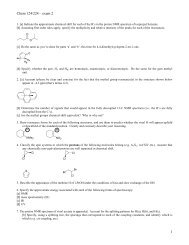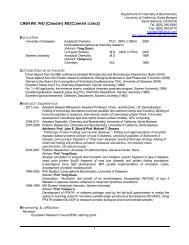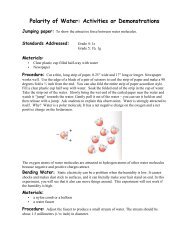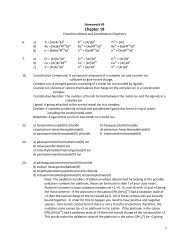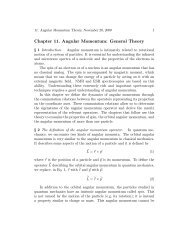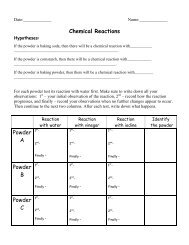Chapter 7. The Eigenvalue Problem
Chapter 7. The Eigenvalue Problem
Chapter 7. The Eigenvalue Problem
You also want an ePaper? Increase the reach of your titles
YUMPU automatically turns print PDFs into web optimized ePapers that Google loves.
<strong>7.</strong> <strong>The</strong> <strong>Eigenvalue</strong> <strong>Problem</strong>, December 17, 2009 8<br />
This is a Hermitian matrix with real elements. Let ψ = {ψ 1 , ψ 2 , ψ 3 } be a<br />
vector. <strong>The</strong>n Aψ =0means(use(Aψ) i = 3<br />
j=1 A ij ψ j )<br />
Aψ =<br />
⎛<br />
⎜<br />
⎝<br />
⎞<br />
A 11 ψ 1 + A 12 ψ 2 + A 13 ψ 3<br />
⎟<br />
A 21 ψ 1 + A 22 ψ 2 + A 23 ψ 3<br />
A 31 ψ 1 + A 32 ψ 2 + A 33 ψ 3<br />
⎠ =<br />
⎛<br />
⎜<br />
⎝<br />
3ψ 1 +2ψ 2 +4ψ 3<br />
2ψ 1 +1.2ψ 2 +3.1ψ 3<br />
4ψ 1 +3.1ψ 2 +4ψ 3<br />
⎞<br />
⎟<br />
⎠ = 0 (36)<br />
If a vector is equal to zero then all its components are zero, and Eq. 36 means<br />
3ψ 1 +2ψ 2 +4ψ 3 =0 (37)<br />
2ψ 1 +1.2ψ 2 +3.1ψ 3 =0 (38)<br />
4ψ 1 +3.1ψ 2 +4ψ 3 =0 (39)<br />
<strong>The</strong> notation Aψ = 0 is a shorthand for these three equations. This is a<br />
homogeneous system of three linear equations.<br />
Similarly if φ = {2.1, 6.2, 4.3} then<br />
is shorthand for<br />
Aψ = φ (40)<br />
3ψ 1 +2ψ 2 +4ψ 3 =2.1 (41)<br />
2ψ 1 +1.2ψ 2 +3.1ψ 3 =6.2 (42)<br />
4ψ 1 +3.1ψ 2 +4ψ 3 =4.3 (43)<br />
This is an inhomogeneous system of three linear equations. If the matrix A<br />
has an inverse A −1 , we can solve Eq. 40 by using<br />
A −1 Aψ = A −1 φ (44)<br />
and<br />
which together lead to<br />
A −1 Aψ = Iψ = ψ (45)<br />
ψ = A −1 φ (46)<br />
You have learned in your mathematics courses about Cramer’s rule, which<br />
allows you to solve Eq. 40. This is tedious to implement and I prefer to




